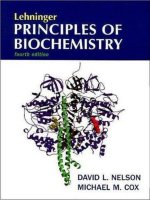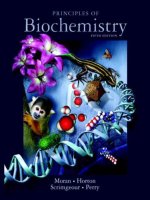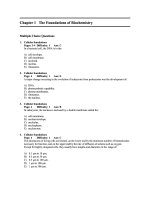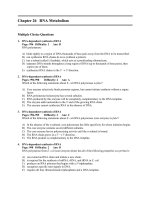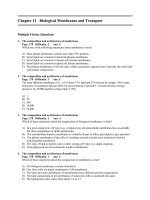kupdf com lehninger principles of biochemistry test bank ch 24pdf
Bạn đang xem bản rút gọn của tài liệu. Xem và tải ngay bản đầy đủ của tài liệu tại đây (162.48 KB, 9 trang )
Chapter 24 Genes and Chromosomes
Multiple Choice Questions
1. Chromosomal elements
Page: 924 Difficulty: 2 Ans: B
The most precise modern definition of a gene is a segment of genetic material that:
A)
B)
C)
D)
E)
codes for one polypeptide.
codes for one polypeptide or RNA product.
determines one phenotype.
determines one trait.
that codes for one protein.
2. Chromosomal elements
Page: 925 Difficulty: 1 Ans: A
The DNA in a bacterial (prokaryotic) chromosome is best described as:
A)
B)
C)
D)
E)
a single circular double-helical molecule.
a single linear double-helical molecule.
a single linear single-stranded molecule.
multiple linear double-helical molecules.
multiple linear single-stranded molecules.
3. Chromosomal elements
Page: 925 Difficulty: 1
Bacterial plasmids:
A)
B)
C)
D)
E)
Ans: E
are always covalently joined to the bacterial chromosome.
are composed of RNA.
are never circular.
cannot replicate when cells divide.
often encode proteins not normally essential to the bacterium’s survival.
4. Chromosomal elements
Page: 925 Difficulty: 1
Ans: B
Which of these statements about nucleic acids is false?
A)
B)
C)
D)
E)
Mitochondria and chloroplasts contain DNA.
Plasmids are genes that encode plasma proteins in mammals.
The chromosome of E. coli is a closed-circular, double-helical DNA.
The DNA of viruses is usually much longer than the viral particle itself.
The genome of many plant viruses is RNA.
Chapter 24 Genes and Chromosomes
5. Chromosomal elements
Pages: 925-927
Difficulty: 2
Functional DNA is not found in:
A)
B)
C)
D)
E)
281
Ans: C
bacterial nucleoids.
chloroplasts.
lysosomes.
mitochondria.
nuclei.
6. Chromosomal elements
Page: 926 Difficulty: 2 Ans: B
The DNA in a eukaryotic chromosome is best described as:
A)
B)
C)
D)
E)
a single circular double-helical molecule.
a single linear double-helical molecule.
a single linear single-stranded molecule.
multiple linear double-helical molecules.
multiple linear single-stranded molecules.
7. Chromosomal elements
Page: 928 Difficulty: 1
Introns:
A)
B)
C)
D)
E)
Ans: D
are frequently present in prokaryotic genes but are rare in eukaryotic genes.
are spliced out before transcription.
are translated but not transcribed.
can occur many times within a single gene.
encode unusual amino acids in proteins.
8. Chromosomal elements
Page: 930 Difficulty: 1 Ans: A
The chromosomal region that is the point of attachment of the mitotic spindle is the:
A)
B)
C)
D)
E)
centromere.
endomere.
exon.
intron.
telomere.
9. DNA supercoiling
Page: 930 Difficulty: 2 Ans: C
DNA in a closed-circular, double-stranded molecule with no net bending of the DNA axis on itself is:
A)
B)
C)
D)
a left-handed helix.
a mixed right- and left-handed helix.
relaxed.
supercoiled.
282
Chapter 24 Genes and Chromosomes
E) underwound.
10. DNA supercoiling
Page: 933 Difficulty: 2 Ans: D
It is correct to say that DNA supercoiling cannot:
A)
B)
C)
D)
E)
be induced by strand separation.
be induced by underwinding of the double helix.
form if there is Z-DNA structure present.
occur if a closed circular double-stranded DNA molecule has a nick.
result in compaction of the DNA structure.
11. DNA supercoiling
Page: 933 Difficulty: 2 Ans: B
The linking number (Lk) of a closed-circular, double-stranded DNA molecule is changed by:
A)
B)
C)
D)
E)
breaking a strand, then rejoining it.
breaking a strand, unwinding or rewinding the DNA, then rejoining it.
breaking all hydrogen bonds in the DNA.
supercoiling without the breaking of any phosphodiester bonds.
underwinding without the breaking of any phosphodiester bonds.
12. DNA supercoiling
Page: 933 Difficulty: 2 Ans: B
For a closed-circular DNA molecule of 10,000 base pairs in the fully relaxed form, the linking
number (Lk) is about:
A)
B)
C)
D)
E)
10,000.
950.
100.
9.5.
2.
13. DNA supercoiling
Pages: 933-934
Difficulty: 3 Ans: C
If the structure of a fully relaxed, closed-circular DNA molecule is changed so that the specific
linking difference (σ) is –0.05, the number of:
A)
B)
C)
D)
E)
bases is decreased by 5%.
bases is increased by 5%.
helical turns is decreased by 5%.
helical turns is increased by 5%.
helical turns is unchanged.
Chapter 24 Genes and Chromosomes
14. DNA supercoiling
Page: 935 Difficulty: 2
Topoisomerases can:
A)
B)
C)
D)
E)
change the linking number (Lk) of a DNA molecule.
change the number of base pairs in a DNA molecule.
change the number of nucleotides in a DNA molecule.
convert D isomers of nucleotides to L isomers.
interconvert DNA and RNA.
15. DNA supercoiling
Page: 937 Difficulty: 2
Topoisomerases:
A)
B)
C)
D)
E)
Ans: A
Ans: E
always change the linking number in increments of 1.
can act on single-stranded DNA circles.
change the degree of supercoiling of a DNA molecule but not its linking number of DNA.
occur in bacteria, but not in eukaryotes.
require energy from ATP.
16. DNA supercoiling
Page: 937 Difficulty: 3 Ans: B
Plectonemic supercoils in a negatively supercoiled DNA molecule:
A)
B)
C)
D)
E)
are always left-handed.
are always right-handed.
are balanced by solenoidal supercoils
can be either right- or left-handed.
never occur.
17. The structure of chromosomes
Page: 939 Difficulty: 2 Ans: C
Histones are _______ that are usually associated with _________.
A)
B)
C)
D)
E)
acidic proteins; DNA
acidic proteins; RNA
basic proteins; DNA
basic proteins; RNA
coenzymes derived from histidine; enzymes
18. The structure of chromosomes
Page: 940 Difficulty: 1 Ans: D
The fundamental repeating unit of organization in a eukaryotic chromosome is:
A) the centrosome.
B) the lysosome.
C) the microsome.
283
284
Chapter 24 Genes and Chromosomes
D) the nucleosome.
E) the polysome.
19. The structure of chromosomes
Page: 940 Difficulty: 2 Ans: C
Which of the following contributes to the structure of nucleosomes?
A)
B)
C)
D)
E)
Plectonemic supercoiled DNA
Relaxed closed-circular DNA
Solenoidal supercoiled DNA
Spacer DNA
Z (left-handed) DNA
20. The structure of chromosomes
Page: 940 Difficulty: 2 Ans: D
Nucleosomes:
A)
B)
C)
D)
E)
are important features of chromosome organization in eukaryotes and bacteria.
are composed of proteins rich in acidic amino acids, such as Asp and Glu.
are composed of protein and RNA.
bind DNA and alter its supercoiling.
occur in chromatin at irregular intervals along the DNA molecule.
21. The structure of chromosomes
Pages: 942-943
Difficulty: 2 Ans: D
A condensed eukaryotic chromosome is known to be associated with all of the following proteins,
except for:
A)
B)
C)
D)
E)
Core histones H2A, H2B, H3, and H4.
Histone H1
SMC proteins
Topoisomerase I
Topoisomerase II
22. The structure of chromosomes
Pages: 943-944
Difficulty: 2 Ans: C
The SMC proteins (for structural maintenance of chromosomes) include cohesins and condensins, and
are known to have all of the following properties except:
A)
B)
C)
D)
E)
A complete ATP binding site.
A hinge region
Topoisomerase activity to produce positive supercoils
The ability to condense DNA
Two coiled-coil domains
Chapter 24 Genes and Chromosomes
23. The structure of chromosomes
Pages: 943-944
Difficulty: 2
Bacterial chromosomes:
A)
B)
C)
D)
E)
285
Ans: A
are highly compacted into structures called nucleoids.
are seen in electron microscopy as “beads on a string”.
are surrounded by a nuclear membrane.
contain large numbers of nucleosomes.
when fully extended are as long as the bacterial cell.
Short Answer Questions
24. Chromosomal elements
Page: 925 Difficulty: 2
Describe the structure and function of a typical bacterial plasmid.
Ans: Bacterial plasmids are generally closed-circular, double-stranded DNA molecules that are much
smaller than the bacterial chromosome itself. They replicate autonomously and may encode proteins
which, although not normally essential to bacterial survival, may confer resistance to antibiotics.
25. Chromosomal elements
Pages: 927-928
Difficulty: 2
Describe a current hypothesis to explain the presence of functional DNA in mitochondria and
chloroplasts.
Ans: These organelles are thought to have originated from aerobic bacteria and photosynthetic
bacteria, which took up endosymbiotic residence within primitive eukaryotic cells. The DNA
molecules of the organelles are putative vestiges of the chromosomes of these bacteria.
26. Chromosomal elements
Page: 928 Difficulty: 2
What are introns?
Ans: Introns are regions of genes (primarily eukaryotic) that in mRNA are transcribed but are not
translated. They do not code for amino acid sequences within the protein that is coded by the gene.
Thus they interrupt the colinearity between the nucleotide sequence of the gene and the amino acid
sequence of the encoded protein.
27. Chromosomal elements
Page: 929 Difficulty: 2
What is satellite DNA?
Ans: Satellite DNA (also known as highly repetitive or simple-sequence DNA) consists of regions of
the eukaryotic genome that are different enough in base composition from the bulk of the
chromosomal DNA that they can be separated from it by density gradient centrifugation. Satellite
DNA is often associated with centromeres and telomeres and consists of short sequences (5 to 10 base
pairs) that are repeated millions of times per cell.
286
Chapter 24 Genes and Chromosomes
28. DNA supercoiling
Page: 930 Difficulty: 2
Describe two functions of DNA supercoiling.
Ans: Supercoiling allows for the extreme compaction required for DNA to fit in a cell. Negative
supercoiling also facilitates the unwinding of the strands of the double helical DNA that is required
for its transcription and replication.
29. DNA supercoiling
Page: 933 Difficulty: 2
Define, in the context of DNA structure, “topological bond.”
Ans: Topological bonds are links between two molecules that are not joined by specific chemical
bonds, but that cannot be physically separated because they cross over each other like links in a chain.
30. DNA supercoiling
Page: 933 Difficulty: 3
Define “specific linking difference” (σ), also called superhelical density.
Ans: The specific linking difference (σ) is a measure of the number of turns removed (∆Lk) relative
to the linking number of the fully relaxed form (Lk0): σ = ∆Lk/Lk0.
31. DNA supercoiling
Pages: 933-935, 940
Difficulty: 2
Indicate whether the following statements are true (T) or false (F).
___ The linking number (Lk) of a closed-circular DNA molecule can be changed only by
breaking one or both strands.
___ DNA of all organisms is overwound (i.e., positively supercoiled).
___ Topoisomerase I relaxes DNA that is highly negatively supercoiled.
___ In a nucleosome, eukaryotic DNA is wrapped around histone proteins.
Ans: T; F; T; T
32. DNA supercoiling
Pages: 933-937, 940
Difficulty: 3
Calculate values for the following topological properties of a closed-circular DNA molecule
containing 2,000 base pairs (for simplicity, assume there are 10 base pairs per turn in the relaxed
DNA).
(a) The linking number when the DNA is relaxed
(b) The linking number when the DNA has been underwound by 10 enzymatic turnovers of
DNA gyrase (+ATP)
(c) The linking number when the DNA has been underwound by binding five nucleosomes
followed by complete relaxation by a eukaryotic topoisomerase
(d) The superhelical density of the DNA molecule in (b)
(e) The superhelical density of the DNA molecule in (c)
Ans: (a) 200; (b) 180; (c) 195 (d) –0.1; (e) –0.025
Chapter 24 Genes and Chromosomes
287
33. DNA supercoiling
Page: 934 Difficulty: 1
Define, in the context of DNA structure, “topoisomers.”
Ans: Topoisomers are different forms of a closed-circular DNA molecule that differ only in a
topological property such as their linking number (Lk).
34. DNA supercoiling
Pages: 935-937
Difficulty: 2
Define topoisomerase, and explain the difference between type I and type II topoisomerases.
Ans: Topoisomerases are enzymes that change the linking number in a closed-circular, doublestranded DNA molecule by breaking one or two strands, adding or removing twists, and rejoining the
strand(s). Type 1 topoisomerases break and rejoin only one strand, changing the linking number in
increments of 1. Type 2 topoisomerases break and rejoin both strands, changing the linking number
in increments of 2.
35. DNA supercoiling
Pages: 935-937
Difficulty: 2
The DNA of virtually every cell is underwound (i.e., negatively supercoiled) relative to B-form DNA.
In bacteria, an enzyme called (a) ____________ introduces negative supertwists into DNA using (b)
____________ as a source of energy. This enzyme is classified as a type (c) ____________, which
affects the linking number in steps of (d) ___________. The usual substrate for this enzyme within
an E. coli cell is the bacterial chromosome. This circular DNA molecule of 4,700,000 base pairs has
a linking number of approximately (e) ____________ when it is closed and relaxed. This enzyme
would (f) ____________ (decrease/increase/not change) this linking number when acting upon this
DNA molecule in the presence of the above energy source.
Ans: (a) E. coli topoisomerase II or DNA gyrase; (b) ATP; (c) type II topoisomerase; (d) two; (e)
450,000; (f) decrease
36. DNA supercoiling
Pages: 937-938
Difficulty: 2
Explain the difference between plectonemic and solenoidal supercoiling of DNA; use diagrams to
help in your explanation.
Ans: In plectonemic supercoiling, the double helix is intertwined such that it crosses over itself. In
solenoidal supercoiling, the double helix forms a spiral resembling the helix formed by each of the
strands. (See Fig. 24-24a, p. 938.)
37. The structure of chromosomes
Page: 939 Difficulty: 2
Briefly describe the changes in eukaryotic chromosome structure during the cell cycle.
Ans: Starting with prophase, the DNA undergoes condensation (employing cohesins and
condensins). During the subsequent metaphase, the condensed chromosomes line up along a plane
halfway between the spindle poles (to which they are connected by microtubules). As the cell moves
into anaphase, the sister chromatids separate, each drawn towards its respective spindle pole. After
288
Chapter 24 Genes and Chromosomes
cell division is complete, the chromosomes decondense, and remain so during interphase. (See Fig.
24-25, p. 939).
38. The structure of chromosomes
Pages: 939-941
Difficulty: 2
What are histones and what is their principal role in chromatin structure?
Ans: Histones are small basic proteins that bind to DNA. There are five main types, four of which
interact with each other to form the core of the nucleosome around which the DNA is wrapped. The
fifth (H1) is believed to be involved in compaction of nucleosomes to form a higher-order structure.
39. The structure of chromosomes
Pages: 940-941
Difficulty: 2
Describe the composition and structure of a nucleosome.
Ans: A nucleosome consists of 146 base pairs of double-stranded DNA wrapped in a solenoidal
supercoil around a core of histones (small, basic proteins). This core contains two copies each of
histones H2A, H2B, H3, and H4.
40. The structure of chromosomes
Page: 942 Difficulty: 2
The overall compaction of a eukaryotic chromosome is greater than ____________ -fold. The first
level is nucleosome formation, which compacts about _________ -fold. Next is the 30 nm fiber,
which compacts about ________ -fold overall. Higher order folding involves association of the DNA
with a nuclear ______________________ , which contains large amounts of ________________ and
___________________ .
Ans: 10,000; 7; 100; scaffold; histone H1; topoisomerase II (last two in either order).
41. The structure of chromosomes
Pages: 943-944
Difficulty: 2
SMC proteins facilitate the structural maintenance of chromosomes; describe the roles of the two
main classes.
Ans: The cohesins help link sister chromatids together after replication and keep them together as
they condense, which is essential for proper segregation. The condensins are essential for DNA
condensation as the cell enters mitosis, and their binding is thought to create positive supercoiling.
(See Fig. 24-25, p. 944).
